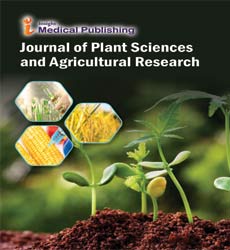Soil Degradation Metrics and Physicochemical Properties for Sustainable Land Management
Bhanti Zahmanova*
Department of Plant Breeding, Swedish University of Agricultural Sciences, Uppsala, Sweden
- *Corresponding Author:
- Bhanti Zahmanova
Department of Plant Breeding, Swedish University of Agricultural Sciences, Uppsala,
Sweden,
E-mail: zahmanova_b@gmail.com
Received date: November 27, 2024, Manuscript No. IPJPSAR-24-20186; Editor assigned date: November 29, 2024, PreQC No. IPJPSAR-24-20186 (PQ); Reviewed date: December 13, 2024, QC No. IPJPSAR-24-20186; Revised date: December 20, 2024, Manuscript No. IPJPSAR-24-20186 (R); Published date: December 27, 2024, DOI: 10.36648/ipjpsar.8.4.165
Citation: Zahmanova B (2024) Soil Degradation Metrics and Physicochemical Properties for Sustainable Land Management. J Plant Sci Agri Res Vol.8 No.4: 165.
Description
Soil degradation is a major environmental issue that directly impacts agricultural productivity, ecosystem health and food security. It refers to the decline in the quality of soil, often resulting from unsustainable farming practices, deforestation, industrialization and urbanization. Over time, soil degradation leads to the loss of soil fertility, structure and water-holding capacity, thereby reducing the land’s ability to support healthy plant growth. To address this challenge, it is need to monitor and assess soil degradation using specific metrics that help guide sustainable land management practices.
Importance in sustainable and management
Soil degradation metrics are indicators used to assess the extent and severity of soil degradation. These metrics focus on various aspects of soil health, including its physical, chemical and biological properties. Commonly used soil degradation metrics include soil erosion, compaction, salinization, acidification and nutrient depletion.
One of the most common and widely studied metrics is soil erosion, which occurs when wind or water removes the topsoil, a layer rich in nutrients and organic matter. Soil erosion not only reduces soil fertility but also leads to sedimentation in rivers and streams, degrading water quality. Erosion can be measured using the erosion rate, which quantifies the amount of soil lost from a given area over time. Tools such as the Universal Soil Loss Equation (USLE) or more advanced remote sensing techniques are commonly used to estimate erosion rates and predict future erosion risks.
Another key metric is soil compaction, which occurs when soil particles are pressed together, reducing the pore space in the soil. This limits water infiltration, root growth and nutrient uptake, leading to decreased crop yields and reduced soil biodiversity. Soil compaction is typically measured using the bulk density of the soil, which is the mass of soil per unit volume. Higher bulk density often indicates more compacted soil, whereas lower bulk density suggests better soil aeration and structure. Monitoring bulk density helps identify areas where compaction is an issue and provides data for selecting appropriate remedial measures, such as reducing heavy machinery use or employing practices like deep tillage to loosen compacted soils.
Salinization is another critical metric in areas where irrigation practices have led to the accumulation of soluble salts in the soil. Excessive salinity interferes with plant growth by affecting the osmotic potential of the soil solution, reducing water availability to plants. It can be quantified by measuring the Electrical Conductivity (EC) of the soil solution, which increases with the concentration of salts. In areas prone to salinization, especially in arid and semi-arid regions, monitoring EC is need for preventing crop failure and land abandonment. Techniques like leaching, proper drainage and the use of salt-tolerant crops are some strategies used to mitigate salinity issues.Soil acidification is another form of degradation where the pH of the soil decreases due to factors such as excessive use of chemical fertilizers, acid rain or poor land management practices.
Physicochemical properties of soil
The physicochemical properties of soil are integral to understanding soil health and are need for the effective management of land resources. These properties include soil texture, structure organic matter content, pH, Cation-Exchange Capacity (CEC) and moisture content. They play a critical role in determining soil fertility, water retention and the overall suitability of land for agricultural production.
One of the most important physicochemical properties is soil texture, which refers to the relative proportions of sand, silt and clay in the soil. Soil texture influences a range of soil functions, including water infiltration, drainage and nutrient retention. Sandy soils, for instance, have large particles that allow for fast drainage but are often low in nutrients and water-holding capacity. In contrast, clay soils have fine particles that retain water and nutrients but may face issues with poor drainage and compaction. Loamy soils, with a balanced mix of sand, silt and clay, are often considered ideal for agricultural use. By analyzing soil texture through a simple texture triangle or using more advanced laboratory methods, land managers can determine the soil's suitability for different crops and adjust farming practices accordingly.
Soil structure refers to the arrangement of soil particles into aggregates or clumps, which affect water movement, root penetration and microbial activity. Well-structured soils promote better aeration, drainage and root growth, while poorly structured soils can lead to problems like waterlogging and erosion. Soil structure can be improved through the addition of organic matter, such as compost or manure, which helps bind soil particles together, improving soil aggregation and enhancing water retention and drainage.
Open Access Journals
- Aquaculture & Veterinary Science
- Chemistry & Chemical Sciences
- Clinical Sciences
- Engineering
- General Science
- Genetics & Molecular Biology
- Health Care & Nursing
- Immunology & Microbiology
- Materials Science
- Mathematics & Physics
- Medical Sciences
- Neurology & Psychiatry
- Oncology & Cancer Science
- Pharmaceutical Sciences
